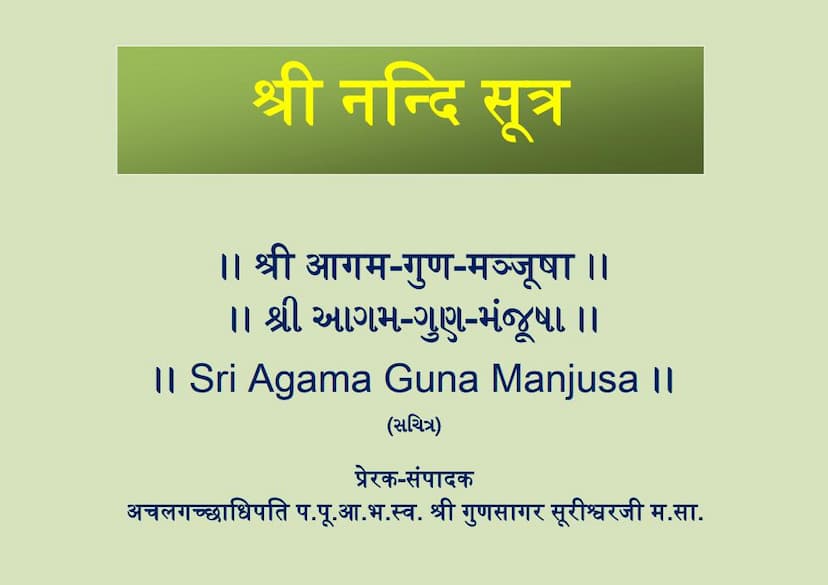Agam 44 Chulika 01 Nandi Sutra Shwetambar Agam Guna Manjusha
Added to library: September 1, 2025

Summary
This document is a descriptive overview of the 45 Jain Agamas, presented in Hindi and English, under the title "Agam 44 Chulika 01 Nandi Sutra Shwetambar Agam Guna Manjusha" by Gunsagarsuri. The text provides a brief introduction to each Agama, categorizing them into Angas, Upangas, Prakirna Sutras, Cheda Sutras, Mula Sutras, and Chulika Sutras.
Here's a summary of the key sections and information:
Overall Purpose:
The publication aims to provide a concise introduction to the 45 sacred Jain scriptures, the Agamas. It serves as a guide to their content, structure, and significance within the Shwetambar tradition. The title "Agam Guna Manjusha" (Treasury of Agama Virtues) suggests a devotional and informative approach.
Categorization of Agamas:
The Agamas are systematically presented in the following categories:
-
Eleven Angas (Primary Scriptures):
- Acārāngasutra: Deals with the conduct of monks and householders, focusing on ways of conduct.
- Suyagaḍānga-sutra (Sūtra-Kṛtānga): Discusses various philosophical views and doctrines.
- Thāṇānga-sutra: Covers a wide range of topics from numbers to objects, encompassing all four Anuyogas.
- Samavāyānga-sutra: A compendium detailing various items from one to crores.
- Vyakhyā-prajñapti-sūtra (Bhagavati-sūtra): The largest Agama, presenting questions and answers of Lord Mahavira to Gautama Ganadhara, covering all four Anuyogas.
- Jäätädharma-Kathānga-sutra: Focuses on religious narratives and discourses.
- Upāsaka-daśānga-sūtra: Describes the vows of householders and the lives of ten great lay disciples.
- Antagaḍa-daśānga-sūtra: Narrates the life stories of souls who attained liberation after practicing penance.
- Anuttarovavayi-daśānga-sūtra: Details the lives of great souls who attained liberation after a single rebirth in higher realms.
- Praśna-vyākaraṇa-sūtra: Deals with transgression and self-control, featuring questions and answers.
- Vipāka-sūtranga-sutra: Describes the fruition of actions, both positive and negative.
-
Twelve Upangas (Subordinate Scriptures):
- Uvavayi-sutra: Describes the city of Champanagari, austerities, and disciples.
- Rāyapaseni-sutra: Depicts the interaction of King Pradeshi with Suryabha Deva.
- Jivābhigama-sutra: Analyzes the nature of soul and non-soul, and the geography of Jambudvipa.
- Pannavaņā-sutra: Describes 36 topics related to Jain philosophy.
- Sūrya-prajñapti-sutra and Chandra-prajñapti-sutra: Deal with astronomical calculations concerning the sun and moon.
- Jambūdvipa-prajñapti-sutra: Provides a detailed description of Jambudvipa.
- Nirayāvali-pacaka (a group of five Upangas):
- Nirayāvali-sutra: Narrates the story of a war and its consequences.
- Kalpāvatamsaka-sutra: Describes the lives of princes.
- Pupphiya-upanga-sutra: Details various deities and celestial beings.
- Pupphacūlikā-sūtra: Describes the previous births of goddesses.
- Vṛṣṇidaśā-upānga-sūtra: Narrates stories of the Vṛṣṇi dynasty.
-
Ten Payanna-sutras (Explanatory Scriptures):
- Includes various scriptures like Āturāpatthyākhyān, Bhaktaparijñā, Saṁsthāraka, etc., covering topics like final practices, types of death, detachment, and astrology.
-
Six Cheda-sutras (Disciplinary Scriptures):
- Vyavahāra-sutra, Nīśītha-Sūtra, Mahāniśītha-sūtra, Pañcakalpa-Sūtra, Daśāśruta-skandha-Sotra, and Bhatkalpa-sutra. These texts deal with strict disciplinary rules, exceptions, and atonement for transgressions. Their study is generally restricted to highly qualified monks.
-
Four Mula-sutras (Root Scriptures):
- Daśavaikālika-sūtra: Described as a "lake of nectar" for monks and nuns, it covers ten lessons and two Chūlikās.
- Uttarādhyayana-sūtra: Contains the final teachings of Lord Mahavira, emphasizing detachment and virtuous conduct.
- Anuyogadvāra-sūtra: Considered the "key to all Agamas," it explains the process of Anuyoga (scriptural exposition) and is essential for understanding other Agamas.
- Āvaśyaka-sūtra: Details the six obligatory daily duties for all Jain followers.
-
Two Chulikas (Appendices):
- Nandi-sutra: Praises Lord Mahavira and the Jain Sangha, enumerates Tirthankaras and Ganadharas, and explains the fivefold knowledge.
- Anuyogadvāra-sutra: (Also listed as a Mula Sutra, it's often considered foundational).
Key Themes and Content:
Across these Agamas, the text highlights:
- Anuyogas: The four branches of Jain knowledge – Dravyanuyoga (entity), Ganitanuyoga (calculation), Dharmakathanuyoga (religious discourse), and Charanakarana-anuyoga (conduct). Different Agamas are noted for their primary focus on one or more of these.
- Conduct and Morality: Emphasis is placed on the ethical conduct of monks, nuns, and householders, covering vows, austerities, and daily practices.
- Philosophy and Doctrine: The Agamas expound upon Jain philosophy, including karma, soul, rebirth, omniscience, and various philosophical schools of thought.
- Life Stories and Narratives: Many Agamas contain biographies of spiritual luminaries, historical accounts, and didactic stories that illustrate religious principles.
- Cosmology and Astronomy: Some Agamas delve into the structure of the universe, celestial bodies, and time cycles.
- Discipline and Practice: The Cheda Sutras are particularly focused on the rigorous discipline and conduct required for spiritual advancement.
- Knowledge: The Nandi Sutra, in particular, is highlighted for its detailed exposition of the five types of knowledge (Mati, Sruta, Avadhi, Manahparyaya, Kevala).
The Nandi Sutra (specifically mentioned in the title):
The Nandi Sutra is described as containing hymns to Lord Mahavira, similes for the Jain community, names of Tirthankaras and Ganadharas, the Sthaviravali (lineage of elders), and a detailed explanation of the five types of knowledge. It is considered foundational for understanding other Agamas.
Overall Value:
This compilation serves as a valuable reference for anyone seeking to understand the vast corpus of Jain Agamas. It provides a structured overview, highlighting the diverse subjects covered and the importance of each scripture within the Jain tradition. The inclusion of both Hindi and English descriptions makes it accessible to a wider audience.